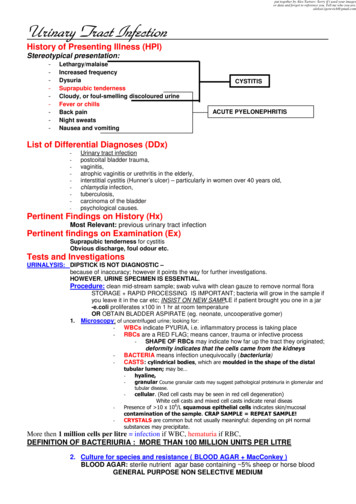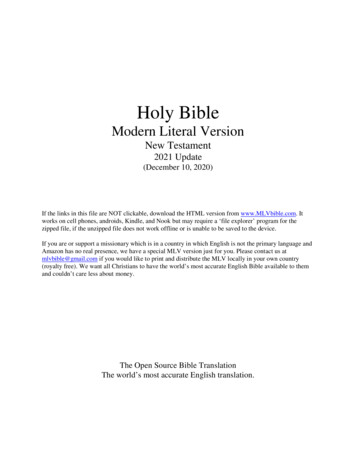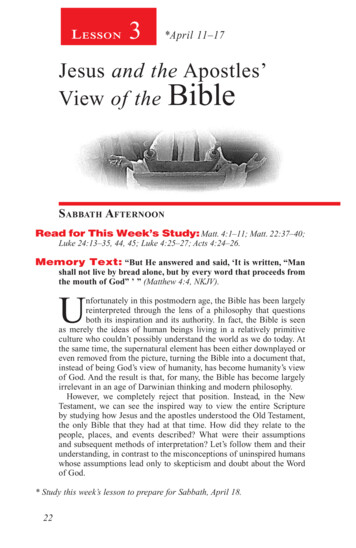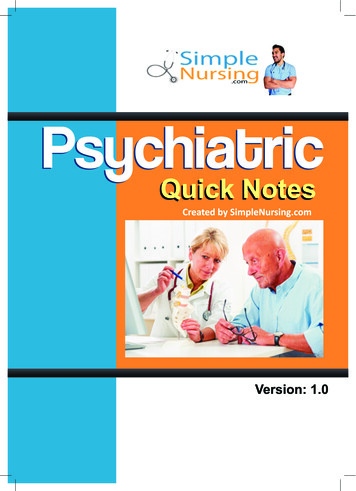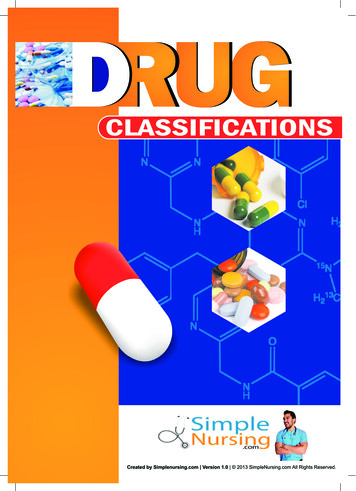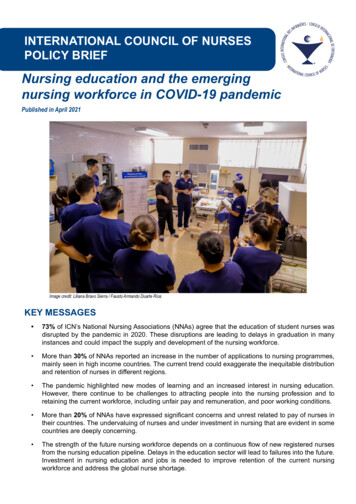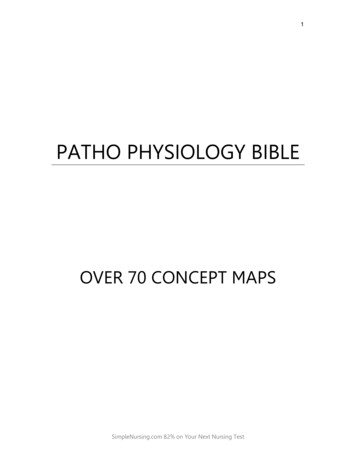
Transcription
1PATHO PHYSIOLOGY BIBLEOVER 70 CONCEPT MAPSSimpleNursing.com 82% on Your Next Nursing Test
2ContentsNEURO: CNS .7Alzheimer’s disease .7PLAN OF CARE: Safety/ LOC/ stress free .7Path physiology .7Brain Tumors .8Path physiology .9Cerebrovascular Accident (CVA) . 10PLAN OF CARE: neuro checks, pain Manage, decrease ICP, monitor RR, . 10Pathophysiology . 10Epilepsy . 12Pathophysiology . 12Head Injury . 15Pathophysiology . 15Traumatic Brain Injury. 15Acquired Brain Injury . 15Multiple Sclerosis . 17Pathophysiology . 17Meningitis . 19Pathophysiology . 19Parkinson's Disease . 20Pathophysiology . 20Seizures . 23Pathophysiology . 23Spinal Cord Injury . 26Pathophysiology . 26NEURO: PNS . 27Guillain-Barre Syndrome . 27Pathophysiology . 27Myasthenia Gravis . 29Pathophysiology . 29Gastro Intestinal (Upper) . 30Esophageal Disorders . 30Pathophysiology . 30Gastritis . 32Pathophysiology . 32Gastroesphageal Reflux Disease (GERD) . 33Pathophysiology . 33Hiatial Hernia . 35Pathophysiology . 35Peptic Ulcer Disease . 37Pathophysiology . 37Gastro Intestinal (Lower) . 39Appendicitis . 39Pathophysiology . 39SimpleNursing.com 82% on Your Next Nursing Test
3Small Bowel Obstruction (SBO) . 41Pathophysiology . 41Constipation . 42Pathophysiology . 42Causes of constipation: . 42Hernia . 44Pathophysiology . 44Symptoms of a hiatal hernia . 44Symptoms of inguinal and femoral hernias . 44Symptoms of an umbilical hernia . 45Symptoms of a congenital diaphragmatic hernia . 45Paralytic Illius. 45Pathophysiology . 46Causes of paralytic ileus . 46Ishemic Bowel . 47Pathophysiology . 47Volvulus . 49Pathophysiology . 49Diverticulitis . 50Pathophysiology . 50Resection of Intestines . 52Description . 52Why the Procedure is Performed . 53Risks . 53Inflammatory Bowel Disease . 53Pathophysiology . 53Colorectal Cancer. 55Pathophysiology . 55Dukes’s Classification of Colorectal Cancer . 56Orthopedics (BONES). 57Hip Fracture . 57Pathophysiology . 57Total Knee Replacement (TKR). 59Pathophysiology . 59Long Bone Injury . 59Pathophysiology . 59Osteoarthritis (OA) . 62Pathophysiology . 62Etiology And Pathophysiology . 62Rheumatoid Arthritis (RA). 64Pathophysiology . 64Gout . 65Pathophysiology . 65Vascular Disorders. 67Peripheral Artery Disease (PAD) . 67Pathophysiology . 67SimpleNursing.com 82% on Your Next Nursing Test
4Peripheral Vein Disease (PVD) . 67Pathophysiology . 67Aneurysms . 68Pathophysiology . 68I. Aortic Aneurysms: . 69II. Cerebral Aneurysm: Signs and symptoms of cerebral aneurysm are: . 69III. Peripheral Aneurysm: Signs and symptoms of peripheral aneurysm are asfollows: . 69Respiratory. 70Bronchial Asthma . 70Pathophysiology . 70Bronchitis . 71Pathophysiology . 71Chronic Obstructive Pulmonary Disease (COPD) . 72Pathophysiology . 72Emphysemia. 74Pathophysiology . 74Hemothorax . 75Pathophysiology . 75Pneumonia . 77Pathophysiology . 77Pneumothorax. 80Pathophysiology . 80Pulmonary Embolism . 81Pathophysiology . 81Respiratory Failure. 84Pathophysiology . 84Tuberculosis (TB) . 85Pathophysiology . 85Upper Respiratory Infection (URI ) . 86Pathophysiology . 86CARDIAC (HEART) . 87Angina . 87Pathophysiology . 87Arrhythmias . 89Pathophysiology . 89Acute Coronary Syndrome (ACS . 90Pathophysiology . 90Atrial Fibrillation (AFIB) . 92Pathophysiology . 92Cardiogenic Shock. 93Pathophysiology . 93Coronary Artery Bypass Graft (CABG). 95Pathophysiology . 95Congestive Heart Failure (CHF) . 96Pathophysiology . 96SimpleNursing.com 82% on Your Next Nursing Test
5Coronary Artery Disease (CAD) . 98Pathophysiology . 98Hypertension (HTN) . 101Pathophysiology . 101Central Nervous System . 101Cardiovascular System . 101Renal System. 101Renin-Angiotensin-Aldosterone system. . 101Hyperlipidemia (high cholestrol) . 103Pathophysiology . 103Myocardial Infarction . 103Pathophysiology . 103Pulmonary Edema. 105Pathophysiology . 105Valvular Heart Diseas . 106Pathophysiology . 106Endocrine . 108Diabetes Mellitus Type 1 . 108Pathophysiology . 108Diabetes Mellitus Type 2 . 110Pathophysiology . 110Hyperglycemia . 111Pathophysiology . 111Hypoglycemia . 114Pathophysiology . 114Diabetic Ketone Acidosis (DKA) . 117Pathophysiology . 117Gallbladder, Liver & Appendix . 117Appendicitis . 118Pathophysiology . 118Cholecystitis . 119Pathophysiology . 119Acute Cholecystitis Pathophysiology . 119Acalculous Cholecystitis Pathophysiology . 119Hepatitis . 121Pathophysiology . 121Pancreatitis . 123Pathophysiology . 123Kidney (RENAL) . 124ARF (Acute Renal Failure). 124Pathophysiology . 124The clinical course of ARF is characterized by the following three phases: . 125Phase 1. Onset . 125Phase 2. Maintenance . 125Phase 3. Recovery. 125CRF (Chronic Renal Failure) . 127SimpleNursing.com 82% on Your Next Nursing Test
6Pathophysiology . 127Nephrotic Syndrome . 130Pathophysiology . 130Kindey Stone (Calculi) . 131Pathophysiology . 131Glomerulonephritis . 133Pathophysiology . 133Transurethral Resection of Prostate (TURP) . 134Pathophysiology . 134UTI (urinary tract infection) . 136Pathophysiology . 136Benign Prostate Hypertrophy (BPH) . 138Pathophysiology . 138SimpleNursing.com 82% on Your Next Nursing Test
7NEURO: CNSAlzheimer’s diseasePLAN OF CARE: Safety/ LOC/ stress freePath physiologyThe classic neuropathology findings in AD include amyloid plaques, neurofibrillarytangles, and synaptic and neuronal cell death. Granulovacuolar degeneration in the hippocampusand amyloid deposition in blood vessels might also be seen on tissue examination, but they arenot required for the diagnosisSigns & Symptoms EarlyoooSubtle changes such as forgetfulnessrecent memory losspoor concentration LateooooooSevere memory lossInability to hold a conversationInability to think abstractly or formulate conceptsPoor hygiene and groomingInappropriate dressInability to perform instrumental activities of daily living Behavioral changesoDepressionoAnxietyoWanderingoImpulsive behavioroCatastrophic reactionsoImitationoEmotional liabilityoWithdrawalNursing Dx Impaired thoughtprocesses related todecline in cognitivefunction Risk for injuryrelated to decline incognitive function Anxiety related toNursing Intervention Provide initial andongoingassessments Administerprescribedmedications. Maximize effectivecommunicationRationale Impairment ofvisual perceptionincreases the risk offalling. Identifypotential risks in theenvironment andheighten awarenessso that caregiversSimpleNursing.com 82% on Your Next Nursing TestGoal Creating livingconditions that areas stress-free aspossible will helpkeep the patientcalm and helpstrengthen hiscognitive abilities,
8 confused thoughtprocessesImbalancednutrition: less thanbody requirementsrelated to cognitivedeclineActivity intolerancerelated to imbalancein activity/restpatternDeficient self-carerelated to cognitivedeclineImpaired socialinteractionDeficientknowledge offamily/caregiverrelated to care forpatient as cognitivefunction declinesIneffective familyprocesses related todecline in patient’s cognitive function Maximizeenvironmentalsafety Promote optimalfunctioning Optimize nutritionand fluid balance Optimizeelimination Reducing anxietyand agitation Promotingindependence inself-care activities Providing forsocialization andintimacy needs Promoting balancedactivity and rest Provide dischargeplanning more aware of thedanger.An impairedcognitive andperceptual disorderare beginning toexperience thetrauma as a result ofthe inability to takeresponsibility forbasic securitycapabilities, orevaluating aparticular situation.Maintain securityby avoiding aconfrontation thatcould improve thebehavior / increasethe risk for injury.Provide the basisfor the evaluation /comparison that willcome, andinfluencing thechoice ofintervention.Noise, crowds, thecrowds are usuallythe excessivesensory neuronsand can increaseinterference.Cause concern,especially in peoplewith perceptualdisorders.The name is a formof self-identity andlead to recognitionof reality and theindividual.Increasing thepossibility ofunderstanding.Brain TumorsPLAN OF CARE: Decrease ICP, pain, n/v, photophobia, monitor RR & o2SimpleNursing.com 82% on Your Next Nursing Testbut that can be atall order.
9Path physiologyBrain tumors may be classified into several groups:those arising from the coverings of the brain (e.g., Dural meningioma),those developing in or on the cranial nerves (e.g., acoustic neuroma),those originating with in brain tissue and metastatic lesions originating elsewhere in the body.Tumors of the pituitary and pineal glands and of cerebral blood vessels are also types of braintumors. Relevant clinical considerations include the location and the histology character of thetumor. Tumors may be benign or malignant.A benign tumor CAN BE SERIOUS!! If occurs in a vital area and can grow large enough to haveeffects as serious as those of a malignant tumor.Signs & Symptoms Severe headache in the morning, increased when coughing, bendingC
PLAN OF CARE: Safety/ LOC/ stress free Path physiology The classic neuropathology findings in AD include amyloid plaques, neurofibrillary tangles, and synaptic and neuronal cell death. Granulovacuolar degeneration in the hippocampus and amyloid deposition in blood vesse
